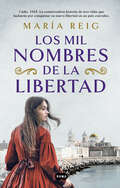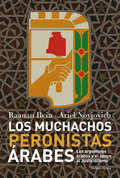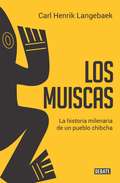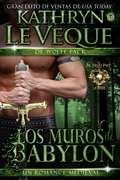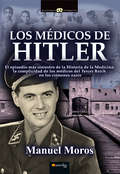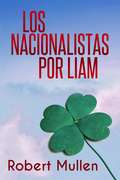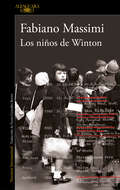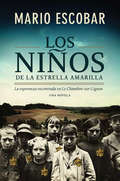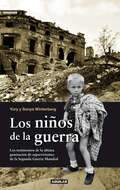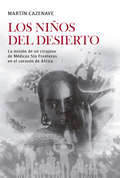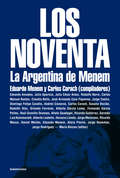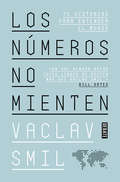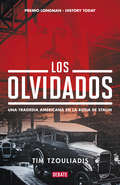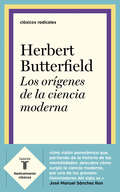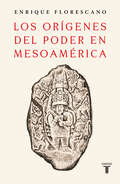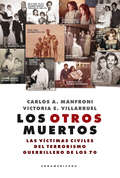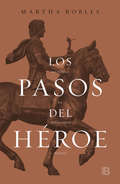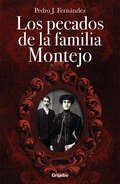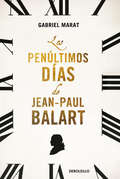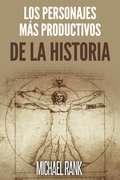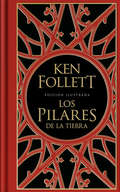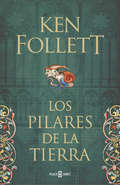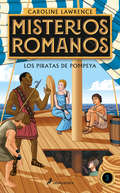- Table View
- List View
Los mil nombres de la libertad
by María ReigCádiz, 1815. Tres vidas marcadas por las consecuencias de la guerra de la Independencia y el nacimiento del estado liberal. ¿Cuál es el verdadero nombre de la libertad? Año 1815.Un momento histórico convulso.Una mujer dispuesta a salvar a su familia. ¿Cuál es el verdadero nombre de la libertad? 1815. La familia De Villalta, burgueses acomodados de Santa Cruz de Tenerife, recibe una carta preocupante y misteriosa en medio de la noche. Tiene que ver con los tristes eventos que han asolado a la familia en los últimos tiempos. Inés, la hija mediana, emprenderá un viaje a la península con la única intención de salvar a su familia. Modesto Andújar llega a Cádiz desde el cortijo de Jerez de la Frontera para estudiar Comercio, aunque su vocación es la política. En su búsqueda de lo que queda del Cádiz de las Cortes, cuna de la Constitución de 1812, se topará con Alonso Guzmán, un tipo de vida pendenciera que busca huir de su pasado. Pero lo que una vez fue irá a su encuentro, en forma de un encargo muy especial. Después del éxito de Papel y tinta y Una promesa de Juventud, María Reig vuelve a hacer alarde de rigor histórico y de una documentación profusa para construir tres vidas marcadas por las consecuencias de la guerra de la Independencia y el nacimiento del estado liberal. Un viaje trepidante por la España de principios del XIX —Madrid, Cádiz, Salamanca, Sevilla, Aranjuez, Asturias— en un momento crítico de unión y división. Intrigas palaciegas, logias masónicas, sociedades liberales, amor, amistad, venganza y aventura se dan cita en una novela prodigiosa. María Reig (Barcelona, 1992) estudió Periodismo en la Universidad Complutense de Madrid y un Máster en Dirección de Comunicación Corporativa en EAE Business School. A los 25 años decidió centrar todos sus esfuerzos profesionales en que su primera novela,Papel y Tinta, viera la luz. En febrero de 2018, desarrolló una campaña de crowdfunding con el objetivo de recaudar fondos para la promoción del libro y en poco más de 24 horas consiguió el fondo requerido y ser publicada por Suma de Letras. Desde entonces Papel y tinta lleva vendidos más de 80.000 ejemplares y los derechos audiovisuales han sido adquiridos para su adaptación a serie de televisión. En 2020 publicó Una promesa de juventud y obtuvo una gran acogida. Los mil nombres de la libertad, su tercera novela, supone su consagración como escritora.www.mariareig.esIG: mariareig.es
Los muchachos peronistas árabes: Los argentinos árabes y el apoyo al Justicialismo
by Raanan Rein Ariel NoyjovichBasados en una minuciosa investigación que exhumó documentación inédita en archivos y repositorios de varios países, Raanan Rein y Ariel Noyjovich presentan la primera historia de la relación entre argentinos-árabes y peronismo. Entre las décadas de 1870 y 1930, decenas de miles de árabes abandonaron Oriente Medio para "hacer la América" en la Argentina, donde se rumoreaba que cualquiera podía vivir libremente y prosperar. Los "turcos" que llegaron al puerto de Buenos Aires tuvieron que enfrentar muchas veces el peso del estereotipo prejuicioso. Ya en la década de 1940, Perón, consciente de estos estereotipos, concibió la idea de asociar a los argentinos-árabes con tres características que, juzgaba, los convertían "naturalmente" en perfectos justicialistas: se trataba, en su mirada, de personas de fuertes sentimientos, nítidamente leales y con una vocación irrenunciable por la justicia social. Los argentinos-árabes, por su parte, encontraron en la integración que el peronismo proponía, la posibilidad de hacerse un espacio en la esfera de la política.
Los muiscas
by Carl Henrik LangebaekEl libro definitivo sobre el pueblo muisca, escrito por Carl Langebaek el más prestigioso arqueólogo colombiano de la actualidad. ¿Dónde estaban ubicados los muiscas?, ¿cuántos eran?, ¿cómo era su organización política?, ¿qué sembraban?, ¿cuál era su tecnología?, ¿qué creían? #El arqueólogo Carl Langebaek, ha estudiado desde los años 80 las antiguas culturas del actual territorio colombiano. Los Muiscas presenta todo lo que la ciencia ha logrado reconstruir sobre este pueblo , la comunidad prehispánica más influyente de su tiempo, que ocupó un territorio del tamaño de suiza y que vivió el primer contacto con los españoles durante el periodo de la conquista. Este texto está pensado para todo el público; busca divulgar la historia de un pasado del que mucho se habla pero poco se conoce.
Los muros de Babylon
by Kathryn Le Veque Mariano GiampietriLos muros de Babylon, de Kathryn Le Veque ¿Podrá el amor sobreponerse a una lucha por el trono? 1471 D.C. - Diez años después de la batalla de Towton, sir Kenton le Bec (de EL LEÓN DEL NORTE) se encuentra al servicio de Warwick, "Hacedor de Reyes". Es su perro de ataque, pues no existe caballero más feroz en el arsenal de Warwick que Kenton le Bec, poderoso y astuto guerrero. A Kenton se le ha encomendado apoderarse de Babylon Castle, una fortaleza que controla el camino entre Lancashire y Yorkshire. Se trata de un castillo estratégico que, de momento, se encuentra en manos de las fuerzas de Eduardo, aspirante al trono. Cuando Kenton y su ejército conquistan esta fortaleza, todo eso cambia. Y, sin embargo, la situación es complicada... Lady Nicola Aubrey-Thorne es la viuda de un importante partidario de Eduardo. Cuando Kenton invade su hogar, Babylon Castle, encuentra en Nicola sólo oposición y odio. Kenton cree encontrarse frente a una mujer que es tan malcriada como bella, alguien que lo antagoniza a diestra y siniestra sólo por despecho. Sin embargo, la chispa de la atracción pronto se hace presente casi desde el primer momento y, a medida que Kenton se entera de los secretos más oscuros de Babylon, va comprendiendo mejor a lady Thorne y sus cuitas. Sus sentimientos por ella comienzan a escapar a su control. Únete a Kenton y Nicola en un mundo de lealtades encontradas y pasiones compartidas. Sé testigo de su amor y su pasión, de cómo sus vidas se entrelazan irrevocablemente a pesar de sus devociones opuestas a reyes enemigos. Se trata de una situación complicada y compleja en la que Kenton y Nicola deberán afrontar difíciles decisiones si desean seguir juntos. Cuando Kenton es capturado por soldados enemigos, Nicola debe hacer lo imposible por salvar al hombre que alguna vez consideró su enemigo pero, ¿llegará a tiempo?
Los médicos de Hitler (Historia Incógnita)
by Manuel Moros PeñaLos crímenes médicos del Tercer Reich y su política de creación de una superraza aria que provocó eliminaciones en masa en campos de exterminio, delirantes ensayos clínicos y atroces experimentos médicos. Una novedosa visión del nazismo como “biología aplicada” que analiza de forma detallada las circunstancias que concurrieron para que un importante sector de la medicina alemana jugara un papel crucial en la política de exterminio del régimen. Los médicos de Hitler analiza de forma detallada y rigurosa cómo el programa de eliminación de niños discapacitados y enfermos mentales, ideado, coordinado y ejecutado por médicos desembocó en el asesinato en masa de los campos de exterminio y en los atroces experimentos médicos llevados a cabo por profesionales de renombre. Un exhaustivo análisis del papel crucial desempeñado por gran parte del colectivo médico en su política de exterminio y de creación de una superraza aria. Un recorrido por todos los aspectos de la biopolítica de exterminio de Hitler, desde los comienzos del movimiento eugenésico en Alemania, la publicación de Mein Kampf, los programas de esterilización forzada, el Aktion 4, las inoculaciones de malaria, los experimentos con gas mostaza,... hasta los procesos judiciales que frenaron este tipo de prácticas.
Los nacionalistas
by Liam Robert MullenEn las reseñas se la describe como “increíblemente precisa”, Los nacionalistas es una historia irlandesa que se sitúa en el sangriento telón de fondo de lo que fue el Alzamiento de Pascua de 1916, la guerra por la independencia y la guerra civil irlandesa. Del autor de The Scribe, The Soaring Spirit, Kolbe y Land of Our Father llega esta nueva novela de gran alcance que abarca los años turbulentos de la historia irlandesa entre 1916 y 1923. El Alzamiento de Pascua de 1916 no fue solo un alzamiento militar, sino que también fue una revolución cultural. Los nacionalistas cuenta la historia de una relación amorosa destinada al fracaso entre un periodista revolucionario y una obstinada muchacha de Kerry perteneciente a La Liga de las Mujeres. La historia también relata la perspectiva de la Iglesia católica en esa época. Con la intervención de personajes ficticios y fácticos, la historia presenta una excéntrica variedad de personajes. Los nacionalistas es el primer libro de lo que será una trilogía. Una poderosa historia de rebelión, amor, redención y pérdida.
Los niños de Winton
by Fabiano MassimiUn thriller trepidante sobre el hombre que salvó a más de seiscientos niños checoeslovacos del nazismo, por el premiado autor de El ángel de Múnich. «Un fresco intrigante que recorre una de las páginas más oscuras de la historia».Patrizia Violi, La Lettura Praga, 1938. La sombra de Hitler se cierne sobre Checoslovaquia. Unos voluntarios británicos liderados por Nicholas Winton, un joven agente de bolsa, se vuelcan en sacar del país en tren y en avión a los niños judíos para llevarlos a Reino Unido. Solo cuentan con la ayuda de Petra, su guía local, que se une a sus actividades clandestinas. En el centro de su empresa se encuentra la misteriosa Niña de la Sal, que todas las noches vende bolsitas de este codiciado ingrediente en las calles de la ciudad. Nadie conoce su nombre ni cómo consigue el preciado bien, pero corre un grave peligro: un gigantesco oficial alemán la está buscando. Una poderosa novela basada en unos hechos reales nunca desvelados hasta 1988, cuando un documental de la BBC hizo pública la lista de los niños, convirtiendo a Nicholas Winton en un héroe y en candidato a Premio Nobel de la Paz. Massimi nos regala un viaje entre la historia y la ficción que ilumina una de las partes más tenebrosas de nuestro pasado. La crítica ha dicho:«Un escritor que conjuga la erudición de un historiador, las fuentes de un periodista y la capacidad narrativa de un novelista».Juan Losa, Público «Una narración delicada [...] dentro de una Praga onírica».Il Libraio «Sin duda, en la mezcla de historia e intriga Massimi demuestra excepcionales dotes».El Imparcial«La solvente irrupción de Massimi viene a nutrir un subgénero propio de la novela negra, el nazi crime».El Periódico de España «Preciso, imaginativo y brillante».Donato Carrisi, Corriere della Sera «Un sutil hilo conductor que une Massimi a las novelas de Kafka y que, en sus relatos de la vida y de los sentimientos durante la formación del pangermanismo, vuelve a revivir a un pueblo muerto y a sus verdugos, recordándonos que no es la gente la que escribe la historia, sino quien sabe controlarla».Roma «Son las pequeñashistorias las que hacen grande la historia, es la narración apasionada la que mantiene vivo el pasado».Domani «Un thriller que podría haber escrito Ken Follett».Il Venerdì (sobre El ángel de Múnich)
Los niños de la estrella amarilla: La esperanza encontrada en Le Chambon-Sur-Lignon
by Mario EscobarJacob y Moises Stein viven con su tía Judit en París hasta que en agosto de 1942 se desata la gran redada contra los judíos extranjeros. Sus padres, una conocidos dramaturgos alemanes se han escondido en la Francia Libre, pero antes de que su tía logre enviarles al sur, los gendarmes los detienen y los llevan al Velódromo de Invierno, donde más de 4 mil niños, 5 mil mujeres y 3 mil hombres tuvieron que subsistir sin comida ni agua durante cinco días. Jacob y Moises logran huir antes de ser enviados en trenes hasta el campo Drancy. Cuando acuden a su casa en París su tía ha desaparecido. Deciden viajar en solitario a Valence para buscar a sus padres, pero el camino no será nada seguro ni fácil.
Los niños de la guerra
by Yury Winterberg Sonya WinterbergLos testimonios de la última generación de supervivientes de la Segunda Guerra mundial. Las vivencias traumáticas que no se superan se transmiten de padres a hijos. El sufrimiento provocado por la Segunda Guerra Mundial sigue removiendo antiguas heridas y el miedo experimentado se transfiere como una vivencia grabada a fuego en la memoria de todos aquellos implicados de algún modo en ella, generación tras generación. Los niños ven el mundo con distintos ojos que los adultos; también la guerra. No aciertan a entender la verdadera naturaleza de las desgracias que trae consigo un conflicto bélico, las interpretan a su manera y desde una perspectiva que responde solo a la verdad y que por eso resulta aterradora. En este libro no solo hablan los niños de la guerra alemanes, sino también los de Polonia, los de Francia, los de Inglaterra y los de la antigua Unión Soviética. La visión de cada uno de estos pequeños y la fuerza de sus testimonios construyen un nuevo escenario, una nueva perspectiva sobre el panorama europeo de aquellos años, sobre lo que significó ser niño en la guerra. Los padres de Yury y Sonia Winterberg conservan intactos sus recuerdos de infancia, la ignominia de algunas circunstancias, el desprecio de los nazis, el miedo... todavía hoy. En Los niños de la guerra recogen con un estilo periodístico lleno de claridad y franqueza 52 testimonios que describen el conflicto desde el principio hasta el final y gracias a la fuerza de las historias, de las cartas de los padres a los hijos momentos antes de ser fusilados, de las fotografías de los álbumes familiares y de los dibujos infantiles obtenemos el mapa emocional, la intrahistoria, del que sin duda ha sido uno de los acontecimientos bélicos de mayor impacto del siglo XX.
Los niños del desierto: La misión de un cirujano de Médicos Sin Fronteras en el corazón de África
by Martín CazenaveLa primera misión de un joven cirujano de Médicos Sin Fronteras en el corazón de África. Una historia verídica de coraje y esperanza, en la que los niños son, a la vez, víctimas y héroes. En 2005 el cirujano argentino Martín Cazenave llega a Sudán como voluntario de Médicos Sin Fronteras. Allí pone toda su experiencia y conocimiento de la medicina al servicio de aquellos que lo necesiten. Durante su misión en Golo, Martín y el equipo se esfuerzan por resolver los cuadros más dramáticos en medio de una cruenta guerra civil cuyas balas y explosiones se escuchan muy cerca. Hasta que un día estallan dentro del hospital. Relato vertiginoso e inspirador sobre las vivencias de un grupo humano de múltiples nacionalidades que, brindando atención médica con recursos limitados a pacientes desesperados en uno de los rincones más desolados del planeta, afronta la gesta de curar, de salvar vidas y de forjar, a cada minuto, la esperanza de un mundo mejor. Una historia verídica de coraje, valor y decisión. En la que los niños son, a la vez, víctimas y héroes. "Un niño se asomó, tímido, con los movimientos cautos de un cachorro que descubre el mundo real. Ya no sonreía, ya no bailaba. Yo observaba su cuerpo diminuto solo para preguntarme: ¿estábamos a la altura de ese niño? ¿Qué habíamos hecho con su mundo?"
Los noventa: La Argentina de Menem
by Carlos Corach Eduardo MenemLa historia definitiva sobre los 90 en la Argentina. Las dos presidencias de Carlos Saúl Menem en la voz de treinta de sus más altos y caracterizados funcionarios de gobierno.Obra de incalculable valor testimonial y documental, se propone como aporte a la comprensión de nuestra historia contemporánea. Carlos Saúl Menem fue presidente de la República entre el 8 de julio de 1989 y el 10 de diciembre de 1999. En esos poco más de diez años el país experimentó el proceso transformador más notable de su historia contemporánea. Profundos cambios en las esferas económica, política, social y cultural dieron lugar a una nueva Argentina que parecía ingresar al siglo XXI con esperanzada vocación de futuro. En efecto, durante los dos mandatos consecutivos de Menem al frente de la Nación, se implementaron reformas y se ejecutaron iniciativas de política pública inéditas en nuestro pasado reciente. El hecho de que las privatizaciones de empresas estatales o la convertibilidad de la moneda se encuentren, como medidas aisladas, entre las primeras cosas que acuden a la memoria colectiva al evocar esos años, habla a las claras de la poca profundidad con que han sido revisados y analizados; al mismo tiempo, señala la necesidad de aportar a su conocimiento a partir de información rigurosa, y a su interpretación desde puntos de vista justos y equilibrados. Con la perspectiva que brindan ya más de veinte años, este libro se propone encarar esa tarea: contar los noventa en primera persona, con datos de primera mano. Los casi treinta autores de esta obra, todos ex funcionarios del presidente Menem, dan cuenta de su labor en sus áreas específicas de gobierno y, en ese mismo gesto, dejan un testimonio de incalculable valor documental e historiográfico, indispensable para las generaciones presentes y las por venir.
Los números no mienten: 71 historias para entender el mundo
by Vaclav SmilUn maestro de los datos y las estadísticas ofrece una visión del mundo tan sorprendente como iluminadora. ¿Es peligroso volar? ¿Qué es peor para el medioambiente, un coche o un móvil? ¿Cuánto pesan todas las vacas del mundo juntos y por qué ese dato importa? ¿Se puede medir la felicidad? La misión de Vaclav Smil es convencernos de que los hechos importan. Científico medioambiental, analista de políticas públicas y autor tremendamente prolífico, es el referente de Bill Gates cuando se trata de entender el mundo. En Los números no mienten, nos embarcamos con Smil en una fascinante expedición en busca de datos que desafían nuestras preconcepciones, al tiempo que nos invita a ver con nuevos ojos el impacto de las transformaciones del mundo moderno sobre la sociedad y el medioambiente. Basado en divertidos ejemplos, estadísticas y gráficas asombrosas, este libro es la combinación perfecta de ingenio, historia y ciencia quecambiará la manera en que vemos el mundo. Es posible que los números no mientan, pero ¿qué verdad transmiten? La crítica ha dicho...«El título de Smil lo dice todo: para entender el mundo hay que examinar las líneas de tendencia, no los titulares. Un retrato fascinante, convincente y sobre todo realista del mundo actual y de hacía dónde nos dirigimos.»Steven Pinker «La palabra "erudito" se inventó para describir a gente como él.»Bill Gates «Uno de los pensadores más importantes del mundo sobre la historia del desarrollo y un maestro del análisis estadístico.»The Guardian
Los olvidados
by Tim TzouliadisEn la década de 1930, la Gran Depresión golpea ferozmente a Estados Unidos y miles de jóvenes sin empleo, defraudados por el sueño americano, que ya no ofrece riqueza ni prosperidad, emigran a la Unión Soviética, el paraíso de los trabajadores, en busca de una oportunidad y de un sueño de signo contrario: el socialismo. Sin embargo, la promesa de un futuro mejor pronto se desmorona al comprobar las duras condiciones en las que han de vivir, y muchos de ellos quieren regresar. Es entonces cuando descubren toda la verdad: han perdido la nacionalidad estadounidense y con ella cualquier posibilidad de retorno. Atrapados en el terror estalinista y olvidados por su país de origen, la mayoría de ellos perecerán en la helada estepa rusa, víctimas de la represión y de los campos de reeducación, extenuados por el frío, el hambre y los trabajos forzados. Fruto de años de investigación en archivos internacionales, Los olvidados constituye una extraordinaria aportación a la historia de las barbaries del siglo XX, al tiempo que contribuye a una mejor comprensión de cuestiones eternas como la culpa y la inocencia que aún hoy nos acosan.
Los olvidados: Una tragedia americana en la Rusia de Stalin
by Tim TzouliadisLa asombrosa y olvidada historia de cómo miles de estadounidenses huyeron de la Gran Depresión a Rusia en busca de empleo y una vida mejor para acabar atrapados en la pesadilla estalinista. En la década de 1930, la Gran Depresión golpea ferozmente a Estados Unidos y miles de jóvenes sin empleo, defraudados por el sueño americano, que ya no ofrece riqueza ni prosperidad, emigran a la Unión Soviética, el paraíso de los trabajadores, en busca de una oportunidad y de un sueño de signo contrario: el socialismo. Sin embargo, la promesa de un futuro mejor pronto se desmorona al comprobar las duras condiciones en las que han de vivir, y muchos de ellos quieren regresar. Es entonces cuando descubren toda la verdad: han perdido la nacionalidad estadounidense y con ella cualquier posibilidad de retorno. Atrapados en el terror estalinista y olvidados por su país de origen, la mayoría de ellos perecerán en la helada estepa rusa, víctimas de larepresión y de los campos de reeducación, extenuados por el frío, el hambre y los trabajos forzados. Fruto de años de investigación en archivos internacionales, Los olvidados constituye una extraordinaria aportación a la historia de las barbaries del siglo XX, al tiempo que contribuye a una mejor comprensión de cuestiones eternas como la culpa y la inocencia que aún hoy nos acosan. La crítica ha dicho...«Notable relato de las vidas de los extranjeros que trabajaron, padecieron y finalmente murieron en la Unión Soviética. La sombría naturaleza del material no consigue acallar la maravillosa voz narrativa de Tzouliadis.»Noel Malcolm, Telegraph «Tzouliadis ha revelado una historia que estadounidenses y soviéticos preferirían olvidar.»Virginia Rounding, The Independent «La lectura de este libro abrirá sus ojos con toda seguridad.»Richard Pipes, The Sun «Tzouliadis conecta brillantemente la alta política con el sufrimiento de personas inocentes añadiendo detalles devastadores.»George Walden, The Observer «Arroja nueva luz sobre un viejo tema, el de la Rusia estalinista, de manera convincente. Y tiene algo verdaderamente inusual en un libro de historia: es totalmente absorbente.»Paul Lay, presidente del jurado del Premio Longman - History Today
Los orígenes de la ciencia moderna
by Herbert ButterfieldUn viaje a la Revolución científica, uno de los momentos más fascinantes de la historia de nuestra cultura. No hay nada más radical que un clásico. Los orígenes de la ciencia moderna es el maravilloso relato de cómo las grandes ideas científicas penetraron en el seno de la sociedad hasta transformar radicalmente el pensamiento occidental. La Revolución científica supuso un cambio de paradigma al romper con el mundo antiguo y medieval no solo en lo referente a la ciencia sino también en el resto de disciplinas. Este libro, esencial para entender la irrupción de la ciencia en el mapa mental de la humanidad, nos recuerda que la idea del método científico, hoy tan asentada, fue una lección difícil de aprender. ---------------------------------- radical: adj. Perteneciente o relativo a la raíz. Clásicos Radicales nace con la misión de recuperar algunos de los libros más emblemáticos del sello que en su día formularon una idea nueva u ofrecieron una mirada original y pertinente sobre las grandes cuestiones universales. Ausentes de las librerías durante demasiado tiempo pero recordados y buscados por los lectores más despiertos, estos textos esenciales de disciplinas como la filosofía, la ética, la historia, la sociología, la economía, la antropología, la psicología y la política mantienen su plena vigencia y vuelven hoy con fuerza para iluminar nuestro presente. ------------- Reseña:«Una visión panorámica que, partiendo de la historia de las mentalidades, descubre cómo surgió la ciencia moderna, por uno de los grandes historiadores del siglo xx.»José Manuel Sánchez Ron
Los orígenes del poder en Mesoamérica
by Enrique FlorescanoUn ensayo sobre los fundamentos del poder político en Mesoamérica y una formidable síntesis histórica del México antiguo La formación del Estado es el proceso civilizador que impulsó el desarrollo de Mesoamérica, el origen de su unidad política y de su identidad social y cultural. Los habitantes de estos territorios construyeron el poder que los organizaría y dotaría de identidad basándose en cuatro pilares: el grupo étnico, el territorio o altépetl, la fundación del reino y la centralización del poder. La particularidad de estas cuatro instituciones no radica, sin embargo, en sus orígenes —ya que las cuatro partieron de procesos sociales y políticos tangibles—, sino más bien en su interiorización en el imaginario colectivo, que tomó forma de mitos, símbolos, imágenes y relatos de matiz religioso e ideológico. En este magnífico ensayo, profusamente ilustrado y actualizado de acuerdo con los descubrimientos más recientes, Enrique Florescano trata desde una perspectiva histórica novedosa la formación del Estado en Mesoamérica, desde su aparición en el Preclásico hasta su abrupto final en las trágicas jornadas de 1521, pasando por los reinos mayas, los poderosos Estados de Teotihuacan, Chichén Itzá y Tula, y los reinos militaristas que dominaron el Posclásico, mostrándonos que la historia política puede situarse en el centro del desarrollo social, económico y cultural de los pueblos que habitaron Mesoamérica.
Los otros muertos: Las víctimas civiles del terrorismo guerrillero de los 70
by Carlos A. Manfroni, Victoria E. VillarruelJuan tenía tres años cuando murió en medio de la balacera de unoperativo montonero. Andrea tenía diez años cuando una bomba activada adistancia por Montoneros destrozó el auto en el que viajaba junto a suspadres, que murieron al instante. Mario Alpern tenía tres hijos y unafábrica cuando un comando lo acribilló a tiros delante de su hijo. Maríade los Ángeles todavía dormía cuando alguien llamó a la puerta de sucasa y su marido Georgie, gerente de la empresa Chrysler, fue a verquién era: vaciaron el cargador de una ametralladora sobre él. Hugotenía veintidós años cuando lo secuestraron por segunda vez; y pese aque su padre pagó un nuevo rescate, lo mataron y arrojaron su cuerpo alcostado de una ruta. Héctor Saraspe tenía dos hijas y atendía el buffetde un club en Tucumán cuando un grupo del ERP lo mató en su lugar detrabajo.Estas son algunas de las historias de las 1.094 víctimas mortales delterrorismo en la Argentina. Familias a las que la Historia y la políticade Derechos Humanos les han dado la espalda. Ellos son los olvidados delos setenta. Este libro, que incluye la lista de muertos, heridos yasesinados, demuestra que las organizaciones armadas atacaron a lapoblación civil y que muchos de quienes participaron de aquellosatentados no sólo cuentan con impunidad absoluta, sino que ademásaparecen ante la política actual como moralmente irreprochables y hastase consideran jueces del resto de la sociedad.Los otros muertos constituye un aporte invalorable para completar lamemoria de nuestro pasado reciente y terminar con la conversión delcrimen en arquetipo del bien.
Los pasos del héroe: Memoria de Alejandro Magno
by Martha RoblesAlejandro de Macedonia mostró desde un inicio la majestuosidad que sólo la influencia de los dioses otorga a los elegidos. Hijo de Filipo II y de la desmesurada Olimpia, Alexandro Magno exhibió desde pequeño un carácter impetuoso. Discípulo de Aristóteles y admirador de Aquiles, la amalgama de influencias que en él confluyeron hicieron que en 32 años de una breve pero poderosa existencia lograra vencer y dominar al ilimitado Imperio persa, fundara ciudades por toda Asia, y que tanto Oriente como Occidente fueran testigos de sus proezas inauditas. Sus conquistas no se ciñeron sólo a lo material, en él todo fue excesivo: la pasión, la fortuna, el azar, el destino, la razón y la superstición. Sus hechos pertenecen al mundo del mito, a la historia y a la literatura, haciendo de él uno de los personajes más extraordinarios de la Antigüedad. «Héroe fue Alejandro, tal vez el último con emoción homérica, apetito de hazañas monumentales y sentido trágico; un gobernante también legendario, porque sus proezas multiplicaron motivos para que nunca dejara de ser personaje ni el tiempo olvidara los episodios que prueban que, sin literatura ni profecías del pasado, la historia quedaría reducida al más aburrido registro de fechas y testimonios».
Los pecados de la familia Montejo
by Pedro J. FernándezCuando Beatriz Montejo descubre que su marido tiene una relación fuera del matrimonio, tomará medidas extremas para impedir que su apellido se mancillado. Con un estilo único y una pluma resuelta, Pedro J. Fernández recrea el esplendor de México durante el Porfiriato hasta el inicio de la Revolución mexicana, a través de la historia de una familia que representa, también, la decadencia del país. Su autor es también la mente detrás de la cuenta de Twitter @DonPorfirioDiaz, sátira enfocada a la divulgación histórica y cultural de México, con casi 170 mil seguidores. Beatriz y Carlos Montejo representan a la clásica familia mexicana de abolengo de finales del siglo XIX. Sus hijos, Juan Carlos, Julio y Ana María, han crecido con los principios que ella les ha inculcado para no perder la estirpe y pertenecer al círculo de allegados de don Porfirio Díaz. Pero la vida no funciona de esa manera... Un día Beatriz descubre que su marido tiene una relación fuera del matrimonio. Como no puede permitir que su apellido se mancille, tomará medidas extremas para mantenerlo impoluto: asesinarlo. Así, descubre que es imposible escapar del pecado, y que necesitará de todos los valores cristianos para salvar a sus hijos de sí mismos, a costa de lo que sea.
Los peces de Maui (¡Arriba la Lectura!, Level Q #78)
by Phillip Simpson Samantha AsriNIMAC-sourced textbook
Los penúltimos días de Jean Paul Balart
by Gabriel MaratUn magnífico thriller que aúna la figura histórica de Kant con una trepidante trama policiaca ambientada en las postrimerías de la dictadura franquista en España. Königsberg, 12 de febrero de 1804. Muere Immanuel Kant, el filósofo más influyente de la Ilustración. Las condolencias llegan de toda Europa, y en su ciudad se celebran unos multitudinarios funerales a los que acuden grandes autoridades de Prusia. Sin embargo, no todos le tienen en tan alta estima. Uno de sus colegas de la universidad, el doctor Johann Daniel Metzger, ayudado por el antiguo criado del filósofo, Martin Lampe, emprenderá una cruzada contra Kant. Barcelona, primavera de 1970. Heriberto Vilalta, dueño de una importante casa de subastas y miembro de la alta burguesía de la ciudad, es asesinado en su despacho. Faltan pocas semanas para que el Generalísimo inicie la que será su última visita a la Ciudad Condal, y la jefatura de policía centra todos sus esfuerzos en garantizar su seguridad. Apremiado a resolver el caso, el inspector Pedro Almansa se encarga de la investigación. A la falta de medios y al escaso interés de sus superiores, se sumarán las trabas que los hijos de la víctima interponen al ocultar información. El inspector Almansa poco a poco descubrirá que lo que parecía un simple robo esconde una trama de intereses cuyo origen se remonta dos siglos atrás. Con una prosa inteligente, salpicada de ironía y sensibilidad, Gabriel Marat se mueve entre la crónica histórica y la narración fantástica, la novela negra y el thriller psicológico, para atrapar al lector en un relato lleno de intriga y acción.
Los personajes más productivos de la historia
by Michael Rank Aurora Ramírez GagoNunca se supo cómo lo hizo. Pocos compositores escriben más de una o dos sinfonías durante su vida. Beethoven dedicó un año para componer sus sinfonías más cortas sin embargo necesitó más de seis años para su novena sinfonía. Pero Georg Philipp Telemann compuso al menos 200 oberturas en un periodo de dos años. A lo largo de su vida, Telemann completó más de 3000 piezas, aunque sólo 800 han sobrevivido hasta nuestros días. No fue el único cuya productividad desafió todo límite de la razón. El científico griego Arquímedes descubrió fenómenos matemáticos que no fueron confirmados hasta 17 siglos después. Isaac Newton creó la física clásica, y fue uno de los inventores del cálculo. Benjamin Franklin escribió, publicó, polemizó, inventó, experimentó y bromeó. Y en ocasiones lo hacía todo a la vez. Theodore Roosevelt fue el primer estadounidense que ganó un cinturón de judo, que cazó, que escribió varios libros y que leía cuatro horas al día, incluso en los momentos más difíciles de su vida política. Este libro explora las vidas de los 18 personajes más productivos de la historia. Analizaremos las culturas en las que nacieron y los métodos que utilizaron para conseguir unos resultados tan arrolladores. Puede que incluso hasta tengamos tiempo de concentrarnos en los quehaceres de nuestras vidas que son realmente significativos.
Los pilares de la Tierra (Saga Los pilares de la Tierra #Volumen 1)
by Ken FollettLa obra maestra de Ken Follett en una lujosa edición especial 30 aniversario con más de un centenar de ilustraciones. Hace treinta años, Ken Follett publicó en español su novela más popular, Los pilares de la Tierra, que ha vendido más de veintisiete millones de ejemplares en todo el mundo. Ahora, por primera vez en una edición ilustrada, el gran maestro de la narrativa de acción y suspense nos transporta de nuevo a la Edad Media, a un fascinante mundo de reyes, damas, caballeros, pugnas feudales, castillos y ciudades amuralladas. El amor y la muerte se entrecruzan vibrantemente en este magistral tapiz cuyo centro es la construcción de una catedral gótica. Esta edición contiene un prólogo del autor y más de cien ilustraciones del artista Markus Weber. Sobre Los pilares de la Tierra han dicho:«Fantástico desde todos los puntos de vista.»El Mundo «Los pilares de la Tierra fue un hito en España, donde todavía sigue siendo el libro más leído de la historia según la Federación del Gremio de Editores.»ABC «Alta política y bajas pasiones (y viceversa) conforman un folletín de grandes dimensiones que confirman a Follett como relojero mayor del reino del bestseller.»Qué leer «Maravilloso... Te atrapará, fascinará y envolverá.»Chicago Tribune «Los pilares de la Tierra hizo de Ken Follet uno de los autores más queridos de nuestro país.»ABC Sevilla «Ken Follett sabe cómo tejer una historia fascinante, con personajes complejos, que todo actor sueña con interpretar.»Donald Sutherland «Me encanta Los pilares de la Tierra, lo recuerdo con mucho cariño [...] es uno de aquellos títulos que se quedan grabados...»Ildefonso Falcones «En Los pilares de la Tierra, Ken Follett nos presenta a unos personajes que consiguen que la historia cobre vida.»Ridley Scott
Los pilares de la Tierra (Saga Los pilares de la Tierra #Volumen 1)
by Ken FollettLos pilares de la Tierra es la obra maestra de Ken Follett y constituye una excepcional evocación de una época de violentas pasiones. Esta edición de Los pilares de la Tierra incluye un prólogo del autor con motivo del 25.º aniversario de la publicación. El gran maestro de la narrativa de acción y suspense nos transporta a la Edad Media, a un fascinante mundo de reyes, damas, caballeros, pugnas feudales, castillos y ciudades amuralladas. El amor y la muerte se entrecruzan vibrantemente en este magistral tapiz cuyo centro es la construcción de una catedral gótica. La historia se inicia con el ahorcamiento público de un inocente y finaliza con la humillación de un rey. Reseñas:«Fantástico desde todos los puntos de vista.»El Mundo «Los pilares de la Tierra fue un hito en España, donde todavía sigue siendo el libro más leído de la historia según la Federación del Gremio de Editores.»ABC «Alta política y bajas pasiones (y viceversa) conforman un folletín de grandes dimensiones que confirman a Follett como relojero mayor del reino del bestseller.»Qué leer «Maravilloso... Te atrapará, fascinará y envolverá.»Chicago Tribune «Los pilares de la Tierra hizo de Ken Follet uno de los autores más queridos de nuestro país.»ABC Sevilla «Ken Follett sabe cómo tejer una historia fascinante, con personajes complejos, que todo actor sueña con interpretar.»Donald Sutherland «Me encanta Los pilares de la Tierra, lo recuerdo con mucho cariño [...] es uno de aquellos títulos que se quedan grabados...»Ildefonso Falcones «En Los pilares de la Tierra, Ken Follett nos presenta a unos personajes que consiguen que la historia cobre vida.»Ridley Scott Los lectores opinan...«Mi libro favorito.»Ana María «Lo he leído tres veces, es fascinante.»Dolores «Un libro que, sin duda, está entre mis favoritos.»Alexander «¡Gran obra!»Andrés «Una historia fantástica, inolvidable.»Faby Reseñas:«Fantástico desde todos los puntos de vista.»El Mundo «Los pilares de la Tierra fue un hito en España, donde todavía sigue siendo el libro más leído de la historia según la Federación del Gremio de Editores.»ABC «Alta política y bajas pasiones (y viceversa) conforman un folletín de grandes dimensiones que confirman a Follett como relojero mayor del reino del bestseller.»Qué leer «Maravilloso... Te atrapará, fascinará y envolverá.»Chicago Tribune «Los pilares de la Tierra hizo de Ken Follet uno de los autores más queridos de nuestro país.»ABC Sevilla «Ken Follett sabe cómo tejer una historia fascinante, con personajes complejos, que todo actor sueña con interpretar.»Donald Sutherland «Me encanta Los pilares de la Tierra, lo recuerdo con mucho cariño [...] es uno de aquellos títulos que se quedan grabados...»Ildefonso Falcones «En Los pilares de la Tierra, Ken Follett nos presenta a unos personajes que consiguen que la historia cobre vida.»Ridley Scott Los lectores opinan...«Mi libro favorito.»Ana María «Lo he leído tres veces, es fascinante.»Dolores «Un libro que, sin duda, está entre mis favoritos.»Alexander «¡Gran obra!»Andrés «Una historia fantástica, inolvidable.»Faby
Los piratas de Pompeya (Misterios romanos #Volumen 3)
by Caroline LawrenceEste tercer volumen de la colección «Misterios romanos» vuelve a combinar con gran amenidad el rigor histórico con las aventuras de sus jóvenes protagonistas. Además de disfrutar de divertidas historias de detectives, los niños aprenderán cómo era la vida en la antigua Roma. La erupción del Vesubio ha dejado un panorama desolador. La ceniza cubre la tierra, el mar se tiñe de rojo y las olas arrojan a lasplayas los cuerpos de las víctimas. Y cuando algunos niños empiezan a desaparecer de un campamento que acoge a cientos de refugiados, Flavia Gémina y sus amigos Jonatán, Nubia y Lupo entran en acción. Sus pesquisas los conducirán hasta El Patrón, un carismático ypoderoso personaje, y tras seguir una peligrosa pista, la pandilla llegará a las cuevas de Sorrento, donde se las verán con piratasy traficantes de esclavos y sabrán por primera vez lo que es estar en peligro de muerte.
